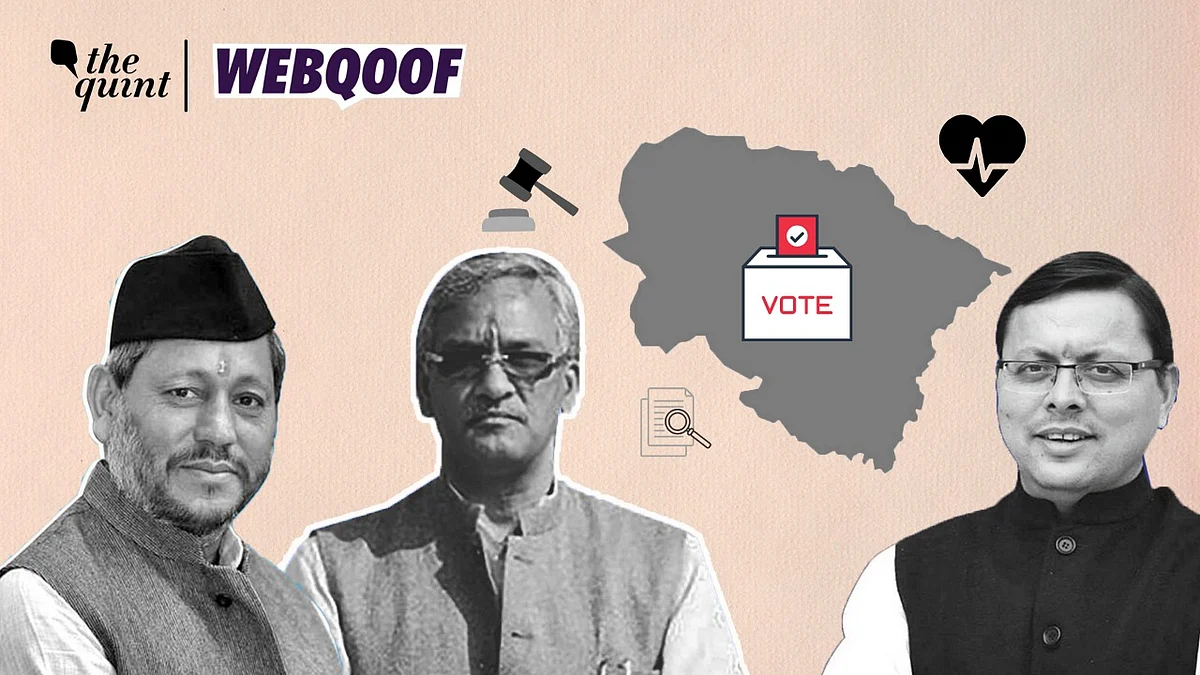Jobs, Crime, and Migration: How Has BJP Fared in Uttarakhand in Last 5 Years?
Uttarakhand has seen a rise in migration triggered by lack of employment in the state.

advertisement
Being the youngest state in the fray in the upcoming state Assembly elections, Uttarakhand has had three chief ministers in the last five years of the Bharatiya Janata Party (BJP) government.
The polls, scheduled to be held on 14 February, are taking place amid the unprecedented price rise and a third wave of the COVID-19 pandemic.
We looked at government reports and data, to see how the current dispensation has performed on several parameters such as crime, employment, and health in the last five years.
Economy of the State Under the BJP
The state's economy, under the BJP government, grew at a slower pace in the last five years than the previous government.
While the growth in the Gross State Domestic Product (GSDP) at constant price increased at an average rate of 7.79 percent between 2012 and 2017 (FY13-FY17), it grew at 6.01 percent between 2017 and 2020 (FY18-FY20), as per the government data.
The per capita income grew at 4.63 percent between 2017 and 2020 (FY18-FY20), while the growth rate was 6.71 percent between FY13 and FY17.
The growth was at par with the national average for the same period.
However, it is important to note that the per capita income in the state has been significantly higher than the national per capita income.
While the per capita income of an average Indian was Rs 94,566 in FY20, the same in Uttarakhand was 1,58,919. The same pattern was seen during the previous governments as well.
What About the Jobs?
The monthly data from the Centre for Monitoring Indian Economy (CMIE), an independent think tank documenting unemployment in India, shows that unemployment in the state has increased in the past five years, with the peak in March 2020 and September 2020, which could be attributed to the lockdown and other curbs due to the pandemic.
In absolute terms, there were 49,000 unemployed people in the state between January and April 2017, with a majority of them (30,000) residing in rural areas.
The number of unemployed people more than doubled to 1,18,000 between September and December 2021.
Further, the labour force participation rate (LPR) for September-December 2021 stood at 31.73 percent, while the employment rate was 30.43 percent.
Migration is another key issue in the state. And as per a report published in September 2019 by Uttarakhand government’s Gramya Vikas aur Palayan Ayog (Rural Development and Migration Commission), the number of uninhabited villages has gone up since the last census (2011).
The most number of uninhabited villages were found in Almora and Pauri Garhwal district.
According to the 2011 census, 1,048 of 16,793 villages in the state were uninhabited and more than 50 percent people in Pauri Garhwal district stated that the main reason for migration was employment.
State Witnesses Rise in Reported IPC Cases
As per the National Crime Records Bureau (NCRB), the number of cases reported under different crime heads (Indian Penal Code) in Uttarakhand has increased under the current BJP government compared to the previous government.
The number of cases reported in 2017 was 12,889, which increased to 13,812 in 2020. Uttarakhand was one of the few states that saw a rise in the number of reported cases in 2020, as most other states saw reduced reporting due to the COVID-19 lockdown.
Crimes against women too rose by 79.2 percent from 2017 to 2020.
The rioting cases have also increased in the state by 40.5 percent since 2016, from 481 to 676.
Infant Mortality and Life Expectancy
One can assess a state's health infrastructure by tracking the Infant Mortality Rate (IMR) and Life Expectancy Rates (LER).
The IMR shows the state of a region's social, economic, and environmental conditions. It is defined as the number of deaths per thousand live births under the age of one.
As per the National Family Health Survey 5 (NFHS), the IMR for Uttarakhand was 39.1 deaths per 1,000 live births.
LER – the number of years a person can expect to live – in the state is declining from 71.5 years (2012-16) to 71 years (2013-17), and 70.9 years between 2014 and 18.
However, the LER has been higher than the national average, which has increased from 68.7 (2012-16), 69 years (2013-17), and 69.4 years (2014-18).
Ease of Doing Business
The Ease of Doing Business – an indicator of the investment-friendly business climate – saw a significant improvement during the previous government from 23 in 2015 to 9 in 2016.
However, the EoDB ranking of the state has fallen by two ranks to 11 since 2017 and remained at the same level in 2019 under the current BJP government, according to the Ease of Doing Business Report, published by the Reserve Bank of India (RBI).
Before the World Bank discontinued its Ease of Doing business report in 2021, India's rank was 63 among 190 countries in 2019, after improving 14 spots since 2018.
(Not convinced of a post or information you came across online and want it verified? Send us the details on WhatsApp at 9643651818, or e-mail it to us at webqoof@thequint.com and we'll fact-check it for you. You can also read all our fact-checked stories here.)